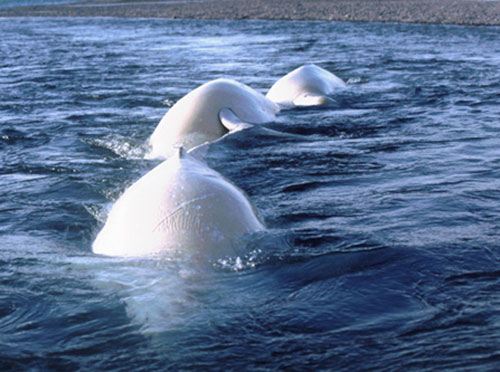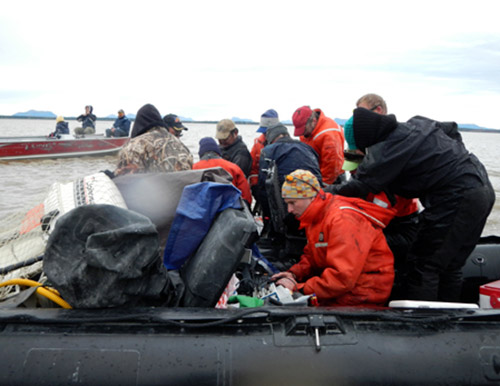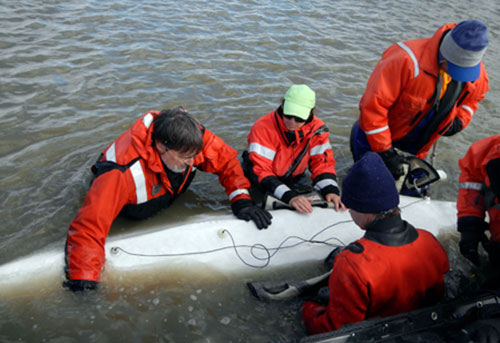
Scientists Test Hearing in Bristol Bay Beluga Whale PopulationFirst published study on hearing in wild cetaceans
May 14, 2014
“Hearing is the main way marine mammals find their way around the ocean,” said Aran Mooney, a biologist at Woods Hole Oceanographic Institution (WHOI). It’s important to know whether and to what extent human activity is negatively impacting them.
A trio of Belugas traveling in Bristol Bay. NMFS permit number 14610. (
“Same way we do it with human infants,” said Mooney. “You play a sound, then you measure the brain's response to the sound.” Though Mooney makes it sound easy enough, he and his colleagues are the first to publish a study of hearing in wild marine mammals, with multiple marine mammals. The paper, “Baseline Hearing Abilities and Variability in Wild Beluga Whales (Delphinapterus leucas)” was published today in The Journal of Experimental Biology, on May 14. In addition to Mooney, the research team included the paper’s lead author Manuel Castellote, from the Alaska Fisheries Science Center, which is part of the National Marine Fisheries Service, and the North Gulf Oceanic Society, and their colleagues from Alaska Department of Fish and Game, Alaska SeaLife Center, and the Georgia Aquarium. The researchers worked over a two week period in southwest Alaska during the summer of 2012, capturing and testing seven Bristol Bay beluga whales, one of six subpopulations of beluga whales in the U.S. Enabling this study are recent advances in portable field testing equipment, rugged enough for field work. To conduct their hearing tests, the team temporarily maintained the individual animals as part of physical health exams. They used suction cups to attach a small speaker to its jaw—which in whales and dolphins conducts sound to both ears—and placed sensors on the animal’s head and back.
WHOI biologist Aran Mooney (foreground) at a computer running a field-based physiological hearing test on a beluga. Using three or four small boats, the team worked with Alaskan natives expert in spotting belugas to guide the animals into water shallow enough to stand in. After temporarily capturing them, they essentially gave them all physical examinations. In human populations, there is variability in our hearing ability: older people don’t hear as well as younger people; males don’t hear high frequencies as well as females. But in the tested beluga population, there was surprisingly little variation. “The bottom line is they all hear pretty well,” said Mooney. “Limitations to our study were that we had just seven animals who live in a pretty quiet environment without a lot of noise exposure. These might conserve their high-frequency better than humans, which makes sense; they need it for echolocation, and if they lose that, then they could lose of their abilities to find food and communicate.” That this kind of study has never been reported before is an indication of the challenge of capturing and testing wild marine mammals. “It's a bit of a project. It takes a lot of people and the right environment. But we've also shown that if you have the right setup it's easy to do,” said Mooney. The team used three or four small inflatable boats and worked with Alaskan natives expert in spotting belugas, which have no dorsal fin and make only the smallest of ripples at the surface when they breathe. The guide the beluga into shallow water – shallow enough to stand in -- until they can gently capture the 8- 12-foot animals with a hoop and net. “Then the animal won't try and swim away, once they feel contained, they're not going to fight,” said Mooney. “They will hang out there. Then you put a belly band stretcher underneath them which has little holes for the flippers. Then it goes over the belly, and that holds the animal during the test.” The team caught and measure three females and four males and essentially gave them all physicals. In addition to the hearing test, they did ultrasounds on each of the animals and collected saliva or mucous from the blow hole to look for stress hormones and took a core of the blubber to look for PCBs and other organic compounds that may build up in the fats. Together, the data gives researchers a baseline of the animals’ health and a way to measure change in the population’s health over time and as environmental conditions change.
Enabled by recent advances in portable field testing equipment, rugged enough for field work, the researchers worked over a two week period in southwest Alaska during the summer of 2012, capturing and testing seven Bristol Bay beluga whales. To conduct their hearing tests, the team temporarily captured individual animals as part of physical health exams. They used suction cups to attach a small speaker to its jaw—which in whales and dolphins conducts sound to both ears—and placed sensors on the animal’s head and back and then recorded its brain's response to the sound. (NMFS permit number 14245)
Another driver for understanding their health and hearing now is a proposed mineral exploration and mining project in the area. The Pebble Mine project would exploit large deposits of copper, gold and molybdenum in the region. “It's not clear if it will directly affect the hearing of the belugas, but it will affect the ecology of what's up there, so the baseline health information is key,” said Mooney. The results of this hearing study may also help validate studies of hearing in belugas in captivity . The team hopes to return to the field this summer to test a larger number of animals and attach temporary data-logging tags to learn more about their foraging, diving, and social behaviors. Funding for the project came from the Georgia Aquarium and the National Marine Mammal Laboratory of the Alaska Fisheries Science Center (NMML/AFSC). Field work also supported by National Marine Fisheries Service Alaska Regional Office (NMFS AKR), WHOI Arctic Research Initiative, WHOI Ocean Life Institute, U.S. Fish and Wildlife Service, Bristol Bay Native Association, Alaska Sea Life Center, Shedd Aquarium and Mystic Aquarium and the Office of Naval Research.
E-mail your news &
photos to editor@sitnews.us
|
||


